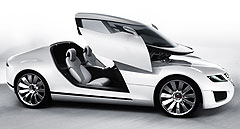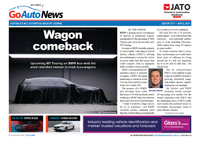Make / Model Search
News - SaabBetter late...Small Saab: GM's Swedish subsidiary finally adopts all-paw technology. Saab admits it was slow to adopt vital trends - but paints a bright future30 Jul 2007 SAAB admits that its slow uptake of trends such as all-wheel drive, diesel and V6s has impeded global sales. This is according to Saab’s global managing director Jan-Ake Jonsson, speaking to the Australian media in Sweden at the launch of the facelifted 9-3 range last month. Mr Jonsson specifically pointed out Saab’s decades-long insistence on sticking purely with front-wheel drive as a main case-in-point. He admitted that not properly exploring other options had proved to be a stumbling block for a company that competes against rear-wheel drive specialists BMW, Mercedes-Benz and, lately, Lexus, as well as brands such as Audi and Volvo which offer all-wheel drive derivatives. “All-wheel drive is the price of entry in the premium sector,” Mr Jonsson said. “(In the past) we felt we had a superior system with front-wheel drive … and felt that all-wheel drive was not that important, because our cars were superior in handling and performance and safety anyway. “So that’s why – I would say – that was the main reason why we were late. “(However) what we have seen more and more is that, lately, the penetration of all-wheel drive has not been all that high, but it is still the price of entry in the premium segment. “You’ve got to have it... so the customers and dealers will be impressed that you have it available. There are many customers that will not consider you if you do not have all-wheel drive. They may not buy it, but they expect you to have it.” Mr Jonsson expects that Saab’s XWD (Cross-Wheel Drive), which will make its Australian debut in the facelifted 9-3 early next year, will be slow on the uptake with consumers at first, but will improve as people begin to associate Saab with all-wheel drive. “I think that when customers realise that we have all-wheel drive, they are going to test front-wheel drive and say, ‘Gee, this is not enough’ – that’s what I think is going to happen,” he said. “We don’t foresee a tremendous migration to all-wheel drive, at least not initially. But as the costs and then the prices come down, and it becomes more affordable, then yeah, maybe we will.” Swedish firm Haldex co-developed the XWD system with Saab, as part of its new fourth-generation Haldex AWD drive program. Mr Jonsson believes that the uptake of XWD will vary according to region. “Some markets it (will be) more than others. In Sweden it is divided, with the northern parts having a higher penetration of all-wheel drive than in the southern parts,” he said. “In Switzerland we have a very high penetration of all-wheel drive, and same with some parts of the US. “But in many other markets it is not such a big issue. Like in the UK... some places are below 10 per cent.”  Left: Aero X concept. Left: Aero X concept.Mr Jonsson confirmed that Saab had been developing an AWD system for many years before it took the plunge to produce it. It showed the possibility with last year’s stunning Aero X concept car – which also previewed design cues of the new 9-3, further development on high-powered ethanol-based engines and the prospects of a sports coupe model in the works. “We had been working on XWD systems for quite some time, but we never really got the system right to properly work for our vehicles,” he said. “We had done a lot of work, on the 9-3 all-wheel drive in particular.” Mr Jonsson also revealed that XWD will spread down the 9-3 range. When launched in the newly facelifted 9-3 as XWD in the second quarter of next year, it will be the sole province of the top-line Aero V6. This means that prices may exceed $85,000. “You will see XWD development being more and more important over time, and operating with some other engine variants,” Mr Jonsson said. He also revealed that all future models would be in line for XWD or something similar. “We are working on a crossover vehicle which will have the new all-wheel drive system we are working on the new 9-5, which will also have an enhanced version of the existing (new XWD) system. “All-wheel drive will be a critical part of every future development at Saab. And of course you can tune (XWD) over time.” However, Mr Jonsson stopped short of confirming that XWD will be included in the 9-1 small car that Saab is co-developing with General Motors Opel in Germany. “You know, in the smaller segment it is too expensive for those customers, I would say, at this point,” he said. “But in the (9-4X) crossover, 9-5 and 9-3, yes.” Mr Jonsson was adamant that Saab would have exclusive use of XWD for the time being. “For the time being we are the only one with GM that is using it,” he emphasised. “(But) there are some competitors who are looking at this application – I know VW is one, and is relatively close. “For the time being, we are the ‘leader’ in all-wheel drive.” Besides AWD, Mr Jonsson also admitted that Saab sales had suffered because the company refused to embrace other emerging trends. “I think that sometimes Saab is known for (sticking with) certain principles (for too long),” he said. “We were very late to get into diesel … (yet) in Europe, in our segment, 55 per cent of total volume is diesel, and we were very late. “We have been a little bit back-and-forth with turbo. At one time it was only turbo, then we introduced normally aspirated...” The Swedish brand’s commitment to turbocharging, combined with its position at the pointy end of forced-induction technology, kept Saab from exploring V6 petrol avenues. “And then we were relatively late to the V6, because we held on to four-cylinder turbo-charging,” Mr Jonsson said. As for jumping on a bandwagon without adhering to Saab principles, the Saab boss was equally frank: “I can tell you... we are never, ever going to do another 9-2X,” he said, referring to the infamous ‘Saab-aru’ based on the outgoing Subaru Impreza that the Swedes sold – in very small numbers – in North America between 2004 and 2006. “It’s as simple as that. It was a serious mistake and it should never have happened,” he said. As far as acquiring the funds and support from within General Motors to help develop the next generation of models and drivetrains, Mr Jonsson said he had unequivocal support. “We have tremendous support for the Saab brand,” he insisted. “You can take the Rick Wagoners... the Bob Lutzs... there is very good support (for Saab). “In the GM portfolio brands, Saab is the European premium brand... in fact, we are the only one. There isn’t anybody else. “If you look at Cadillac, a Cadillac customer would never look at a Saab, just as a Saab customer would never look at a Cadillac. They are very different brands. “And the European premium segment is growing – throughout the world. It is a segment that is becoming more and more important. “And that is why from a GM perspective it is so important that we can play, because there is nothing else that they can do.” Read more:First drive: All paws for effect as Saab evolves 9-3Saab’s double-or-nothing bet First look: Saab Aero X concept is the real deal! |
Click to shareSaab articlesMotor industry news |









Facebook Twitter Instagram